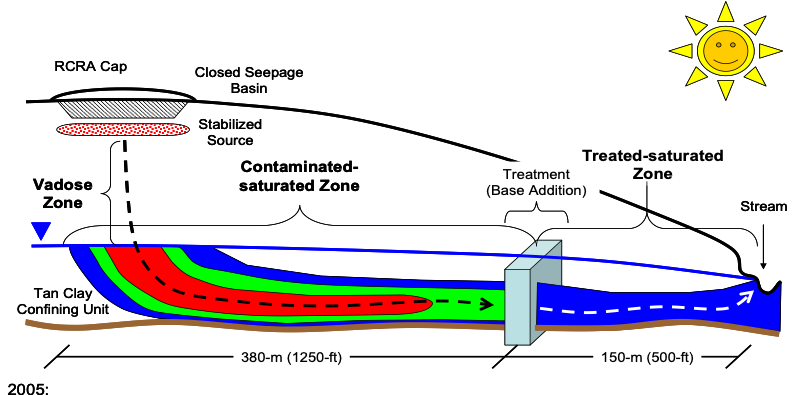Savannah River Site F-Area
The ALTEMIS project uses the site of the SRS F-Area Seepage Basins to demonstrate how the project would establish a new paradigm of long-term monitoring based on the implementation of state-of-art technologies. The seepage basins consist of three unlined, earthen surface impoundments that received approximately 1.8 billion gallons (7.1 billion liters) of acidic, low-level waste (average influent pH of 2.9) which originated from the processing of irradiated uranium in the F-Area Separations facility from 1950 through 1989. The plume currently extends from the basins approximately 600 m downgradient to a stream (Figure 1) and contains a large number of contaminants, of which the most hazardous based on risk to potential receptors are uranium isotopes, Sr-90, I-129, Tc-99, tritium, and nitrate. Groundwater is currently acidic, with pH values as low as 3.2 near the basins. As a result, the sediments that underlie the F-Area have been altered by acidic solutions for about 40 years.

Remediation History
The history of the F-Area Seepage Basins is depicted in the timeline in Figure 2. The F-area Seepage Basin began operating in 1955 and received processed liquid effluent from the Separations Facilities until 1988. In 1986, the determination was made that the basins should be regulated under the Resource Conservation and Recovery Act (RCRA) as hazardous waste disposal facilities, and closure plans were initiated. The basins were closed by dewatering, physically and chemically stabilizing the remaining sludge, and covering them with a protective multilayer system to reduce rainwater infiltration. The basin closures were completed in 1991.
Several remediation strategies have been attempted, are active, and are planned at the F-Area. A pump-and-treat remediation system began operation in 1997 to remove most of the radionuclides except tritium and reinjected the treated water upgradient of the basins. The pump-and-treat was replaced in 2004 by a hybrid funnel-and-gate system installed about 300 m upgradient from the stream to reduce the flux of contaminants to the wetlands adjacent to Fourmile Branch. Alkaline solutions are now being injected into the gates in an attempt to neutralize the acidic groundwater downgradient of the seepage basins and immobilize many of the cationic constituents. In 2009, a pilot study was initiated to evaluate the removal of I-129 by the injection of particles of solid silver chloride upgradient of the base injections. Contaminant I-129 and natural I-127 react with the silver chloride to form insoluble silver iodide, removing I-129 from the groundwater.

Monitoring Wells

